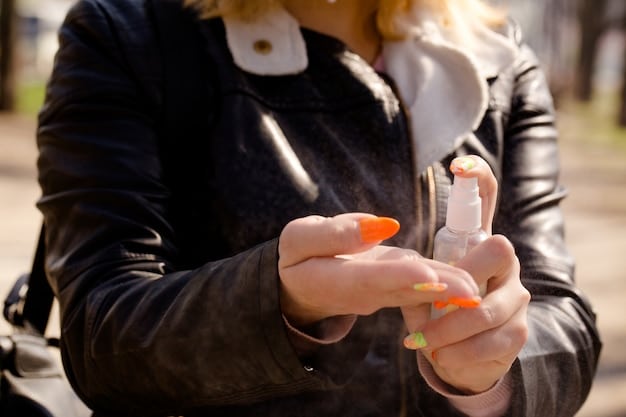Perfume Allergies & Sensitivities: A Guide for German Consumers

Advertisements
Understanding perfume allergies and sensitivities is crucial for German consumers to avoid adverse reactions; this guide provides insights into identifying triggers, recognizing symptoms, and managing perfume-related skin issues.
Ever wondered why that new perfume causes more sniffles than compliments? This guide is designed for German consumers seeking to understand perfume allergies and sensitivities, providing practical advice to navigate the world of fragrances without skin irritation and respiratory discomfort.
Advertisements
Understanding Perfume Allergies: An Introduction
Perfume allergies and sensitivities are becoming increasingly prevalent among German consumers. It is important to understand the difference between a true allergic reaction and a sensitivity, since they can show with different discomfort levels. This section introduces the basics you need to know.
Fragrances are complex mixtures of natural and synthetic chemicals. While they provide a pleasant aroma, these components can also trigger adverse reactions in susceptible individuals. It is crucial for consumers to identify these triggers and understand how to manage their exposure.
Advertisements
What is a Perfume Allergy?
A perfume allergy is an immune system response to certain ingredients in fragrances. When the body identifies a substance as harmful, it releases antibodies that trigger allergic symptoms. These reactions can range from mild skin irritation to more severe systemic responses.
What is Perfume Sensitivity?
Perfume sensitivity, on the other hand, does not involve the immune system. Instead, it represents a heightened reaction to certain chemicals in fragrances that irritate the skin or respiratory system. Sensitivity symptoms are typically less severe than allergic reactions.

Managing perfume allergies and sensitivities begins with awareness. German consumers should be vigilant about reading product labels and understanding the ingredients in their favorite fragrances to get ahead of any reaction. Being proactive can minimize exposure to potential allergens and irritants.
Identifying Common Allergens in Perfumes
Many ingredients in perfumes can trigger allergic reactions; it’s crucial to know what to look for. Let’s examine some of the most common culprits, offering insights into how to identify them on product labels and in descriptions.
Certain fragranced products, including those widely available in Germany, are more likely to contain allergenic ingredients. By understanding what these substances are, consumers can make more informed choices when purchasing perfumes.
- Fragrance Mix Allergens: Many perfumes contain a mix of fragrance chemicals, instead of listing the chemical allergens.
- Linalool and Limonene: These are naturally occurring fragrance compounds often found in essential oils, but they can be irritating to sensitive skin.
- Synthetic Musks: These chemicals are an important component of many fragrances, but have been known to cause allergic skin reactions.
Navigating the world of perfume ingredients can be challenging, but resources are available to help. Online databases and apps can provide detailed information about the potential allergens in specific products, empowering consumers to make safer choices.
Recognizing the Symptoms of Perfume Allergies
Recognizing perfume allergy symptoms is the first step in managing allergic reactions to fragrances. This section outlines common symptoms, helping German consumers identify reactions to fragrances.
Symptoms can manifest differently from person to person, and can range from mild discomfort to severe reactions. It is important to be able to differentiate between localized skin reactions and systemic symptoms to seek appropriate treatment.
Skin Reactions
Skin reactions are one of the most common manifestations of perfume allergies. These reactions typically involve redness, itching, and the formation of blisters or hives at the site of contact.
Respiratory Symptoms
Respiratory symptoms can also occur, especially in individuals with asthma or allergies. These symptoms may include sneezing, coughing, runny nose, and difficulty breathing.
If you experience any of these symptoms after using a perfume, discontinue use immediately and consult a healthcare professional. Early intervention can prevent the reaction from escalating and minimize long-term discomfort.

How to Test for Perfume Allergies
Testing for perfume allergies is essential for those who suspect they may be sensitive to certain fragrances. Various methods can help pinpoint the specific allergens responsible for adverse reactions.
Many German dermatologists specialize in allergy testing and can provide accurate diagnoses and personalized treatment plans. These tests can help individuals identify the exact ingredients they need to avoid to prevent allergic reactions.
- Patch Testing: A small amount of potential allergens are applied to patches, which are then placed on the skin for 48 hours to observe the reaction.
- RAST Test: This blood test measures the levels of specific IgE antibodies to identify allergies.
- Skin Prick Test: Uses diluted allergens to see if the body has a reaction to the allergen.
The results of allergy tests can provide valuable information for managing perfume sensitivities. Armed with this knowledge, consumers can confidently select products that are less likely to cause allergic reactions, enhancing comfort and well-being.
Preventing Perfume Allergies: Practical Tips
Preventing perfume allergies involves proactive strategies to minimize exposure to potential irritants. These strategies include making informed product choices and adopting habits that reduce the risk of allergic reactions.
Simple changes in habits can significantly reduce the likelihood of experiencing perfume-related allergies. German consumers can implement these strategies in their daily lives to protect their health and well-being.
Read Labels Carefully
Make sure to check for ingredients. Look out for chemicals and fragrances that you know will cause a reaction.
Opt for Fragrance-Free Products
Fragrance-free products often contain fewer irritants and allergens. Consider using these alternatives, especially in personal care items and household cleaners.
By adopting these strategies, German consumers can significantly reduce their risk of developing perfume allergies. Prioritizing awareness and making informed choices are key to enjoying fragrances without adverse health effects.
Treatment Options for Perfume Allergies
Effective treatment options are available for managing perfume allergies, providing relief from symptoms and improving quality of life. These treatments range from over-the-counter remedies to prescription medications, tailored to the severity of the allergic reaction.
German consumers have access to various healthcare professionals who can diagnose and manage perfume allergies effectively. Dermatologists, allergists, and general practitioners can provide personalized treatment plans based on individual needs.
- Topical Corticosteroids: These creams can reduce inflammation on the skin.
- Antihistamines: Help relieve symptoms like itching, sneezing, and runny nose.
- Allergen Immunotherapy: Allergy shots slowly introduce your body to allergens.
Seeking prompt medical attention and following a prescribed treatment plan can significantly alleviate the symptoms of perfume allergies. With the right care, individuals can effectively manage their condition and maintain a comfortable lifestyle.
In conclusion, understanding, identifying, preventing, and effectively treating perfume allergies is essential for German consumers. By staying informed and proactive, individuals can minimize their risk of experiencing adverse reactions to fragrances.
| Key Point | Brief Description |
|---|---|
| ⚠️ Common Allergens | Fragrance mixes, linalool, limonene, and synthetic musks. |
| Symptoms | Skin reactions, respiratory issues such as sneezing and coughing. |
| Prevention | Read labels, choose fragrance-free products, and use caution. |
| Treatment | Topical corticosteroids, antihistamines, and allergen immunotherapy. |
Frequently Asked Questions
▼
Main symptoms include skin reactions such as redness, itching, and hives, as well as respiratory symptoms like sneezing, coughing, and difficulty breathing.
▼
Patch testing, Skin prick tests, and RAST tests are common methods performed by dermatologists to identify specific allergens causing reactions to perfumes.
▼
Common allergens include fragrance mixes, linalool, limonene, and synthetic musks. Always check product labels for these substances to prevent allergic reactions.
▼
Fragrance-free products generally contain fewer irritants and allergens, making them a safer option for individuals with sensitivities. Still, always check the ingredient list.
▼
Treatment options include topical corticosteroids, antihistamines, and allergen immunotherapy, all of which aim to reduce inflammation and manage allergic symptoms effectively.
Conclusion
Understanding perfume allergies and sensitivities is crucial for German consumers seeking to enjoy fragrances without adverse health effects. Armed with the information in this guide, individuals can make informed choices, prevent allergic reactions, and effectively manage their symptoms, ensuring a comfortable and fragrant lifestyle.